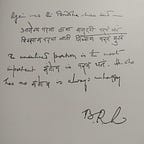The rage and resistance of the marginalized -the subtext of Karnan
A little too late but this had to be written. A couple of weeks ago, I watched Karnan on OTT along with my family. The movie left a lasting impact on many of us, given the subtext of the film is about the assertive power of marginalized communities against oppressive social structures and administrative apparatus of the state.
Karnan is based on the Kodiyankulam massacre in 1995 in the state of Tamizh Nadu. Mari Selvaraj, the director of this film makes a statement about the rage and resistance of a marginalized community from Podiyankulam, which is constantly in conflict with a nearby village Melur. The naming of the villages in Mari’s world itself is evidence to the oppressive structures prevailing in the story.
He uses interesting metaphors to drive home the point in his story. For example, the interval bang is marvelously built. A set of parallel events transpire into a full-blown law and order crisis. A donkey, whose front legs are bound, frequently makes an appearance and right at the moment it is released from its bondage, we get to see the villagers revolting against their oppressors, led by Karnan.
The antagonism in the film is also portrayed by a preying Eagle that steals a chicken from a grandma’s flock to which she curses the eagle of consequences involving the clipping of its wings. This clearly indicates the power imbalance and the character of the antagonists involved in the storyline.
The very first shot in the film is hard-hitting and from the very start narrates how untouchability manifests itself in invisibilizing the existence of the Podiyankulam. Kattupechi the local deity, who is believed to be the dead ancestors of the Podiyankulam Villagers is also used to guide and foreshadow the plotlines. In fact, there is an entire song dedicated to driving this point home.
The clever usage of metaphors involving references from Thalapathy, Pariyerum Perumal, and different animals by the director is interesting and marvelous. The Rajini image on Karnan’s vest refers to Surya from Thalapathy where Karnan is seen as someone who keeps sacrificing, but in Mari Selvaraj’s world, he’s a rebel standing up to oppression. He is a Victor against the conniving actions of Kannabiran, the cop who doubles down upon an entire village after realizing they’re all from the “same community”. His pride takes a hit after what he views as an unusual attitude of people from a marginalized community. They talk back to him, don’t mind offering him a chair and the village headman ends up placing his hand on the officer’s arm.
Hours later, the village elders get assaulted in the Police station by Kannabiran, where he indeed seems to be offended by the names like Duryodhanan, Karnan, Yaman, etc. This incident eventually boils down to a final showdown between Kannabiran and Karnan where Karnan questions the apathy and the supremacist gaze of the state and the oppressor communities that hardly bother to address the grievance of the marginalized but are offended by their assertive actions.
Karnan often keeps revolting and nudging the villagers towards action, asserting against oppressive structures in the society. Be it annihilating a bus or even beheading the egotistic Kannabiran. He educates his villagers in realizing their self-respect. He calls upon them to strengthen his hands towards protecting their dignity. Karnan isn’t anything like his namesake from Mahabharata. In fact, the opening sequence makes it amply clear as to who Karnan is. He is demystified and humanized to an extent that the mythical references in the film allowed the filmmaker to connect him to the realities of oppression and marginalization.
Apart from the important subtext in the film, the director etched his characters brilliantly. For instance, Yaman is one interesting character that is pivotal to the film. There’s an entire song dedicated to his backstory that connects the prophecy of death in the film. True to his name, Yaman prevents deaths in the village by paying with his own life. Mari Selvaraj also attempts to create his own cinematic universe with the Pariyerum Perumal reference in the film.
Mari cleverly places proverbs to indicate the subtext of a scene. For instance, a Tamizh Quote that roughly translates into saying that our aspirations get fulfilled after a long struggle shows up twice in the film right before a young boy hurls a stone at a bus, and parallelly, Karnan unburdens the Donkey of its bondage.
Karnan is easily one of the best works in Tamizh Cinema. The lyrics penned by Mari Selvaraj himself, add to the heft of the storyline filled with mythological references and the presence of animals. The music by Santosh Narayanan is satiating for an audiophile with a powerful background score beefing up the intensity of the screenplay. The film is a great attempt at portraying the life cycle of violence on Dalits and the inevitable assertive revolt against it brilliantly. To sum it up, It’s a wonderful exhibition of anti-caste filmmaking.
